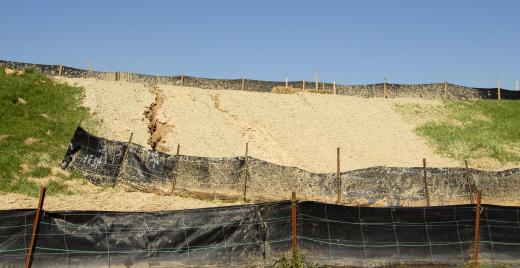A silt fence is a barrier to trap sediment temporarily during periods of soil disturbance like construction. The law may require people to install silt fences for certain kinds of projects, or they can be strongly encouraged, depending on the type of project and the setting. Once the fence is in place, regular maintenance is necessary to keep it in good working condition. For permanent sediment control, other measures are more appropriate.
The silt fence consists of a thick mesh fabric stretched between poles positioned downslope of flow from the site where the soil disturbance will occur. People must partially backfill the upslope section of the fence to promote filtration of sediment, and a series of fences may be necessary to control runoff. Silt fences prevent sediments from entering nearby waterways, and they can also reduce erosion by keeping fine soils and other materials on a site, rather than allowing them to be carried off with stormwater.

Before any kind of soil disturbance occurs, the silt fence should be set in place. There are a number of design approaches, and it is important to make sure the fence is firmly seated and appropriately placed. When multiple runs of fencing are necessary, they should work well with each other to prevent sediment loss. People can also design the fencing to create things like sediment filtration ponds, allowing suspended particles in runoff to filter to the ground before the water flows through the fence.

Once in place, one big problem with a silt fence is clogging. The mesh will slowly fill with fine particles and floods may result as water becomes trapped by the fence and then spills over. Fences can also collapse under pressure from water, mud, and other materials, allowing runoff to spill freely. Tears and rips in the tough fabric can also occur, especially if a fence is left up too long. On sites with high sediment production, a simple silt fence may not be enough to control the problem, and it can become necessary to turn to other sediment control tools as well.
Construction companies should install a silt fence before starting work or hire a fencing company to do so, depending on their experience and needs. Construction inspectors may examine the fence to make sure it is appropriate for the setting and to confirm that the installation is sturdy. If there is a problem with the silt fence, the company can be subject to fines, as well as an order to redo it.
Ever since she began contributing to the site several years ago, Mary has embraced the exciting challenge of being a About Mechanics researcher and writer. Mary has a liberal arts degree from Goddard College and spends her free time reading, cooking, and exploring the great outdoors.

